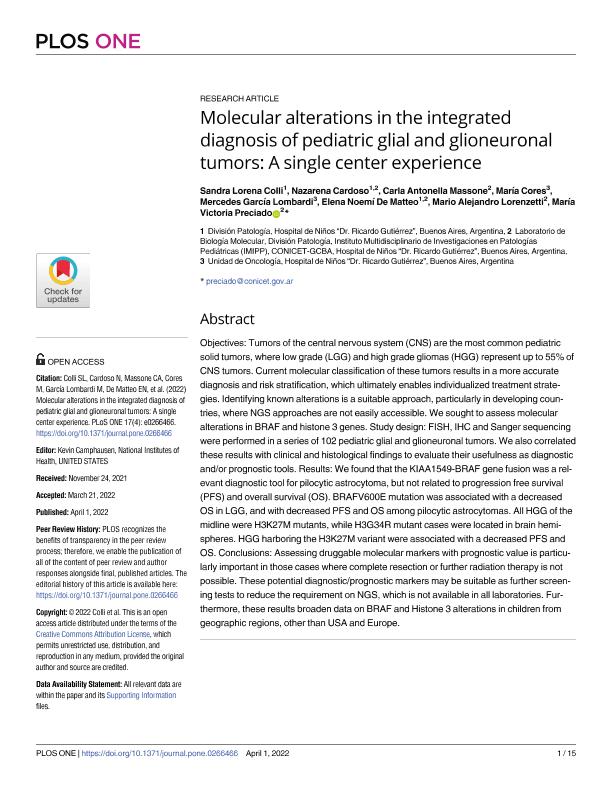Artículo
Molecular alterations in the integrated diagnosis of pediatric glial and glioneuronal tumors: A single center experience
Colli, Sandra Lorena; Cardoso, Nazarena; Massone, Carla Antonella; Cores, María; García Lombardi, Mercedes; de Matteo, Elena Noemí ; Lorenzetti, Mario Alejandro
; Lorenzetti, Mario Alejandro ; Preciado, María Victoria
; Preciado, María Victoria
 ; Lorenzetti, Mario Alejandro
; Lorenzetti, Mario Alejandro ; Preciado, María Victoria
; Preciado, María Victoria
Fecha de publicación:
04/2022
Editorial:
Public Library of Science
Revista:
Plos One
ISSN:
1932-6203
Idioma:
Inglés
Tipo de recurso:
Artículo publicado
Clasificación temática:
Resumen
Objectives: Tumors of the central nervous system (CNS) are the most common pediatric solid tumors, where low grade (LGG) and high grade gliomas (HGG) represent up to 55% of CNS tumors. Current molecular classification of these tumors results in a more accurate diagnosis and risk stratification, which ultimately enables individualized treatment strategies. Identifying known alterations is a suitable approach, particularly in developing countries, where NGS approaches are not easily accessible. We sought to assess molecular alterations in BRAF and histone 3 genes. Study design: FISH, IHC and Sanger sequencing were performed in a series of 102 pediatric glial and glioneuronal tumors. We also correlated these results with clinical and histological findings to evaluate their usefulness as diagnostic and/or prognostic tools. Results: We found that the KIAA1549-BRAF gene fusion was a relevant diagnostic tool for pilocytic astrocytoma, but not related to progression free survival (PFS) and overall survival (OS). BRAFV600E mutation was associated with a decreased OS in LGG, and with decreased PFS and OS among pilocytic astrocytomas. All HGG of the midline were H3K27M mutants, while H3G34R mutant cases were located in brain hemispheres. HGG harboring the H3K27M variant were associated with a decreased PFS and OS. Conclusions: Assessing druggable molecular markers with prognostic value is particularly important in those cases where complete resection or further radiation therapy is not possible. These potential diagnostic/prognostic markers may be suitable as further screening tests to reduce the requirement on NGS, which is not available in all laboratories. Furthermore, these results broaden data on BRAF and Histone 3 alterations in children from geographic regions, other than USA and Europe.
Palabras clave:
glioneuronal
,
pediatric
,
BRAF
,
Histone 3
Archivos asociados
Licencia
Identificadores
Colecciones
Articulos(IMIPP)
Articulos de INSTITUTO MULTIDISCIPLINARIO DE INVESTIGACIONES EN PATOLOGIAS PEDIATRICAS
Articulos de INSTITUTO MULTIDISCIPLINARIO DE INVESTIGACIONES EN PATOLOGIAS PEDIATRICAS
Citación
Colli, Sandra Lorena; Cardoso, Nazarena; Massone, Carla Antonella; Cores, María; García Lombardi, Mercedes; et al.; Molecular alterations in the integrated diagnosis of pediatric glial and glioneuronal tumors: A single center experience; Public Library of Science; Plos One; 17; 4-2022; 1-15
Compartir
Altmétricas



